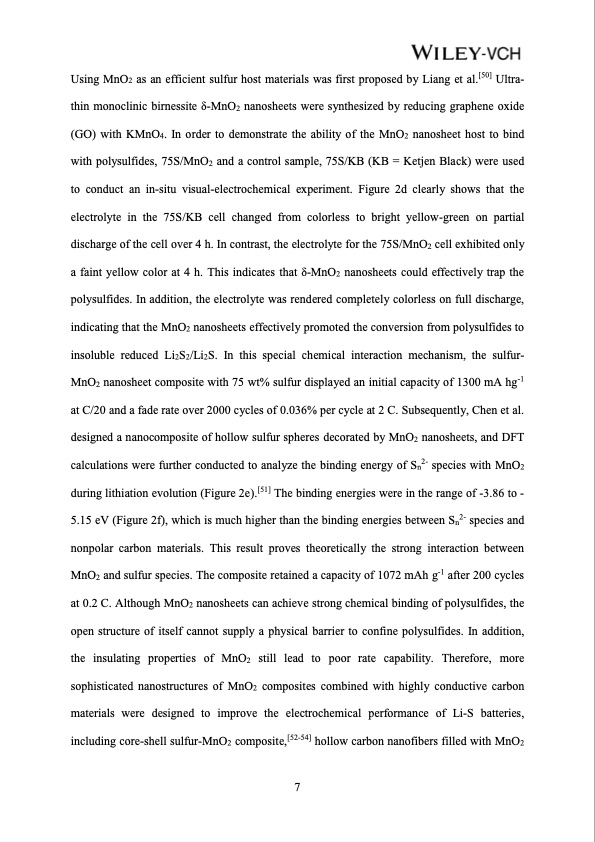
PDF Publication Title:
Text from PDF Page: 009
Using MnO2 as an efficient sulfur host materials was first proposed by Liang et al.[50] Ultra- thin monoclinic birnessite δ-MnO2 nanosheets were synthesized by reducing graphene oxide (GO) with KMnO4. In order to demonstrate the ability of the MnO2 nanosheet host to bind with polysulfides, 75S/MnO2 and a control sample, 75S/KB (KB = Ketjen Black) were used to conduct an in-situ visual-electrochemical experiment. Figure 2d clearly shows that the electrolyte in the 75S/KB cell changed from colorless to bright yellow-green on partial discharge of the cell over 4 h. In contrast, the electrolyte for the 75S/MnO2 cell exhibited only a faint yellow color at 4 h. This indicates that δ-MnO2 nanosheets could effectively trap the polysulfides. In addition, the electrolyte was rendered completely colorless on full discharge, indicating that the MnO2 nanosheets effectively promoted the conversion from polysulfides to insoluble reduced Li2S2/Li2S. In this special chemical interaction mechanism, the sulfur- MnO2 nanosheet composite with 75 wt% sulfur displayed an initial capacity of 1300 mA hg-1 at C/20 and a fade rate over 2000 cycles of 0.036% per cycle at 2 C. Subsequently, Chen et al. designed a nanocomposite of hollow sulfur spheres decorated by MnO2 nanosheets, and DFT calculations were further conducted to analyze the binding energy of Sn2- species with MnO2 during lithiation evolution (Figure 2e).[51] The binding energies were in the range of -3.86 to - 5.15 eV (Figure 2f), which is much higher than the binding energies between Sn2- species and nonpolar carbon materials. This result proves theoretically the strong interaction between MnO2 and sulfur species. The composite retained a capacity of 1072 mAh g-1 after 200 cycles at 0.2 C. Although MnO2 nanosheets can achieve strong chemical binding of polysulfides, the open structure of itself cannot supply a physical barrier to confine polysulfides. In addition, the insulating properties of MnO2 still lead to poor rate capability. Therefore, more sophisticated nanostructures of MnO2 composites combined with highly conductive carbon materials were designed to improve the electrochemical performance of Li-S batteries, including core-shell sulfur-MnO2 composite,[52-54] hollow carbon nanofibers filled with MnO2 7PDF Image | Advances in Polar Materials for Lithium-Sulfur Batteries

PDF Search Title:
Advances in Polar Materials for Lithium-Sulfur BatteriesOriginal File Name Searched:
212718644.pdfDIY PDF Search: Google It | Yahoo | Bing
Sulfur Deposition on Carbon Nanofibers using Supercritical CO2 Sulfur Deposition on Carbon Nanofibers using Supercritical CO2. Gamma sulfur also known as mother of pearl sulfur and nacreous sulfur... More Info
CO2 Organic Rankine Cycle Experimenter Platform The supercritical CO2 phase change system is both a heat pump and organic rankine cycle which can be used for those purposes and as a supercritical extractor for advanced subcritical and supercritical extraction technology. Uses include producing nanoparticles, precious metal CO2 extraction, lithium battery recycling, and other applications... More Info
| CONTACT TEL: 608-238-6001 Email: greg@infinityturbine.com | RSS | AMP |